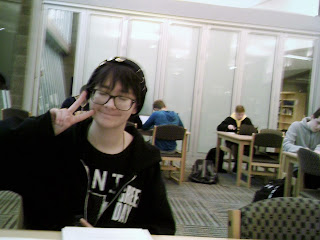Composition I and II
For Digital Photography I, we had an assignment to take notes on different aspects of composition, and to show that we know how to apply these aspects by creating a blog post to showcase what we learned. To showcase these aspects, we went out and took pictures ourselves. These are the results.
Rule of Thirds
If you imagine the frame divided into three lines across and three lines down, the subject would meet at an intersection. Rather than centering, some images look better falling on the intersection of these imaginary lines. My subject, Ray Roles, falls neatly on an intersection, causing the image to look more well-thought out, and displaying the basic photography "rule of thirds."
Pattern
Pattern is a fairly simple aspect of photography. This image was taken of the streets in Prague, and showcases a basic but pleasing pattern.
Symmetry
This image was also taken in Prague, and showcases the symmetrical setting of the exterior of a cathedral. In some situations, symmetry can be pleasing to look at and can fit into what a person may idealize.
Texture
Texture is another notable aspect of composition. If the texture of something pops out, the viewer can get a more realistic feel of the photo. This image displays the texture of a keyboard. The viewer can easily get a feel of these keys that stick out in the image. That can help create a pleasing feel to the photo.
Depth of Field
The depth of a photo can add more life to it. This is a simple picture of a hallway in the school, but because there is depth to it, the three-dimensional aspect becomes more pleasing in composition.
Lines
The steady lines of the lockers can be pleasing to the viewer. In more in-depth composition, lines can also highlight a subject. The use of lines can be very effective in photography, creating more depth to the image.
Framing
Many people like to put photos in picture frames to make them stand out more, but in photography composition, a subject may be put in a natural frame as well. My subject, Lauren Bryant, was framed by a window area in a European castle, highlighting her as the subject.
Perspective
The perspective of an image can change a lot. This photo of a ground view of a cityscape, which may be a lot different if the perspective was from the side or from above. Perspective gives the viewer insight on the photo, setting the scene from which the photography was viewing.
Space
In some settings, giving a subject space can feel more intimate. My subject, Emma Terris, was against a white wall for this photo, giving a sense that she is the most important aspect of the photo. An important part of composition is how someone uses their space. I used my space to create a more up close and personal view of my subject, but filling a space can also help as well.
Balance
Balance is something that comes more naturally to a photo and over all makes it look more aesthetically pleasing. The balance of this photo displays the foreground, background, and space in the scene. The balance is what simply makes the image feel
right, and is more about what the eye can see.
Color
In this photo, many neutral shades are seen in the background, but the part of the image that pops out the most is the pink. Color is what can make a subject pop out more easily, and enhances the composition of a photo. Be it one color or many, color can bring out a lot in a picture.
What I Learned
In this assignment, I learned that there is a lot that goes into composition, and there is no one way for a photo to look good. Different aspects of composition should be taken into account while an image is being produced, and I learned about a handful of these aspects, many of which can help me improve as a photographer while I keep them in mind.






























